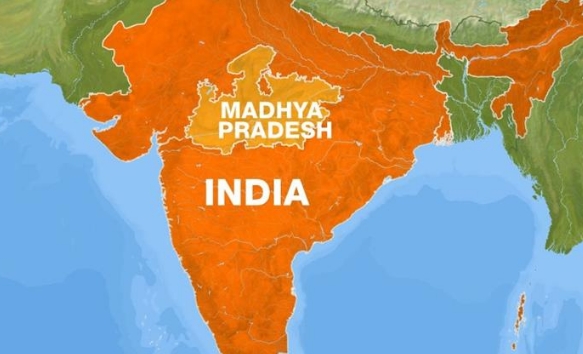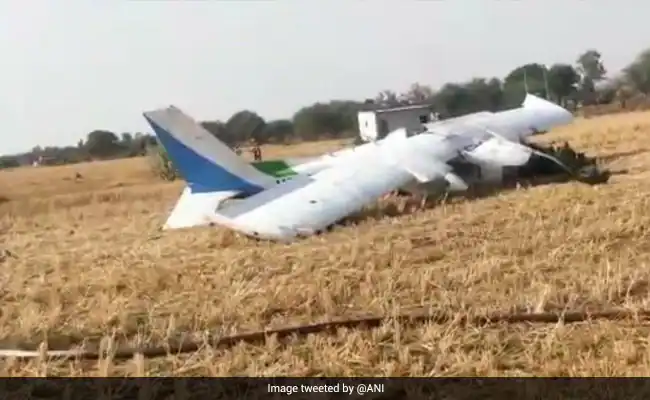Headline
New Year Stampede At Indian Shrine Kills Scores

Twelve people were crushed to death in a stampede at an Indian religious shrine in the early hours of Saturday as tens of thousands of pilgrims massed to offer prayers, officials said.
The disaster unfolded in darkness at around 3:00 am (2130 GMT) on the packed route to the Vaishno Devi shrine in Indian-administered Kashmir, visited by millions every year as one of Hinduism’s most revered sites.
“People fell over each other… It was difficult to figure out whose leg or arms were tangled with whose,” survivor Ravinder told AFP by phone.
“I helped pick up eight bodies by the time ambulances arrived after about half an hour. I feel lucky to be alive but am still shaking with memory of what I saw,” he said.
Video footage showed terrified pilgrims clinging onto metal rafters to escape the rush and the blue lights of small minivan ambulances flashing in the darkness as they tried to rush to hospitals through huge crowds.
Officials sought to blame an alleged altercation between two groups of youths and a rush of people for New Year’s Day.
“Police and officials… were quick to respond (after the altercation), and the order within the crowd was immediately restored,” local police chief Dilbag Singh told the Press Trust of India news agency.
“But by that time, the damage had been done,” he said.
But witnesses said that the authorities were badly organised, something denied by the shrine’s management.
Around a dozen people were also injured.
– Holy sites –
Millions of shrines dot Hindu-majority India’s cities, towns and villages as well as remote sites in the Himalayas and jungles in the south.
Some are hugely important pilgrimage sites, and Prime Minister Narendra Modi’s Hindu nationalist government has invested heavily in improving infrastructure to ease access.
Before the pandemic, every day about 100,000 devotees would trek up a steep winding track to the narrow cave containing the shrine to Vaishno Devi.
“There were at least 100,000 people there. No one was checking registration slips of the devotees,” said Ravinder, who only gave one name.
“I have been there many times but (I have) never seen such a rush of people,” he said.
“It was only when some of us managed to lift a dead body up with our hands that people could see (what was happening) and made space for moving the bodies out.”
Another witness who came from Ghaziabad outside New Delhi with a group of around 10 people said there was clearly “mismanagement”.
“If (they had known) that so much crowding was happening, they should have stopped the people,” the man said without giving his name.
READ ALSO: 2022: Adeboye, Olukoya Release New Year Prophecies For Nigeria
– Horse or helicopter –
In 2008, two stampedes in as many months in India left more than 370 Hindus dead. Others in Kerala in 2011 and in Madhya Pradesh two years later each killed more than 100.
The shrine to Vaishno Devi, a manifestation of Hindu goddess Vaishnavi, is in the hills some 60 kilometres from the city of Jammu. It saw 8.5 million visitors in 2018.
People travel to the nearby busy town of Katra and then trek upwards for around 15 kilometres on foot or by pony — there is also a helicopter service — along a winding track lined with stalls as well as monkeys.
Once they have reached the cave entrance they often have to wait for hours.
Modi, wearing a saffron scarf, rode a pony up to the shrine shortly before being elected in 2014.
He said on Twitter that he was “extremely saddened” by the tragedy.
AFP
Headline
British Family Accused Of Boarding Dead Grandmother On EasyJet Flight

A British family has been accused of trying to board a dead relative onto an EasyJet flight from Málaga, Spain, to London Gatwick on Thursday, passengers said.
The woman, reportedly 89 years old, was wheeled onto the plane by five family members, who told airline staff she was unwell and had fallen asleep.
Witnesses said the woman was pushed in a wheelchair to the rear of the plane and lifted into her seat. Some claimed they overheard a family member tell a boarding clerk, “It’s OK, she’s just tired,” adding, “It’s OK, we’re doctors.”
READ ALSO:Gunmen Invade Church, Kill Priest’s Wife In Anambra
Just before takeoff, the cabin crew realized the woman had died, and the plane was turned around, delaying the flight by 12 hours.
Petra Boddington, a passenger, said: “easyJet, when did you start letting dead people onto planes? Seriously!” Another, Tracy-Ann Kitching, added: “I saw her being wheeled onto the plane; someone was holding her head as they passed me! A doctor on board confirmed that was already dead when they sat her down.”
EasyJet has denied that a deceased person boarded the plane. The airline said the passenger had a fit-to-fly certificate and was alive when she boarded.
READ ALSO:UK Charges Nigerian-British Art Dealer Ochuko Ojiri With Terrorism-related Offence
“The flight returned to the stand prior to take-off due to a customer on board requiring urgent medical assistance. The flight was met by emergency services, but sadly the customer passed away,” a spokesperson said.
The Guardia Civil in Málaga confirmed officers attended the aircraft, and the woman was declared dead on board. No arrests have been made.
Headline
Russian Strike On Odesa Region Kills Eight, Injures 27

Ukraine’s State Emergency Service has reported at least eight people killed and 27 others injured on Friday night after a Russian ballistic missile strike hit the southern Ukrainian city of Odesa.
According to Ukrainian authorities, the attack targeted port infrastructure facilities in the town of Pivdenne, near Odesa, and damaged nearby civilian vehicles.
The strike came one week after much of Odesa was left without power, heat, and water following a “severe” aerial assault.
“Some of the injured were on a bus that was at the epicenter of the shelling. Trucks caught fire in the parking lot, and cars were also damaged,” the State Emergency Service said.
READ ALSO:Russia Insists Ukraine Must Cede Land Or Face Continued Military Push
Emergency officials said the deaths occurred at a port infrastructure facility. Medical teams and first responders were deployed after the strike, but their work was disrupted by “ongoing air raid alerts,” according to Oleh Kiper, head of Odesa’s regional administration.
Russia has carried out repeated attacks on Odesa in recent days, damaging port facilities, civilian vessels, and key infrastructure.
Two major bridges linking the northern and southern parts of the Odesa region have also been hit, with repairs under way, Kiper said.
Elsewhere, Ukraine’s State Emergency Service reported a “massive” drone attack on the southern Mykolayiv region, which damaged civilian infrastructure and vehicles. No casualties were reported.
READ ALSO:19 Die From Alcohol Poisoning In Russia
Odesa, Ukraine’s largest seaport and a major hub in the Black Sea region, has been a frequent target since the start of the war.
Last week, civilian, energy, and industrial sites in the city suffered extensive damage after what regional officials described as “one of the enemy’s most severe airstrikes,” leaving many areas without power and water.
Russia’s Defence Ministry has not commented on the attack.
Speaking hours before the strike during his annual Direct Line call-in show, Russian President Vladimir Putin said Russia was yet to “see Ukraine’s readiness for peace”.
“[Russia] is ready for negotiations and for ending the conflict via peaceful means,” Putin said, adding that it was up to Russia’s “Western opponents” to end the war.
(CNN)
Headline
Aircraft Crashes In Owerri With Four Persons Onboard

A Cessna 172 aircraft with registration number 5N-ASR, operated by Skypower Express, has crashed at the Sam Mbakwe International Cargo Airport, Owerri, Imo State.
The aircraft had departed Kaduna International Airport en route to Port Harcourt International Airport before diverting to Owerri after the crew declared an emergency.
The crash occurred at about 8:00 pm on the airport premises, with four passengers and crew members onboard.
Confirming the incident, the Director, Public Affairs and Family Assistance of the Nigerian Safety Investigation Bureau (NSIB), Mrs. Bimbo Oladeji, said the agency had been notified of the crash.
READ ALSO:Social Media Feud Spills Into Aircraft As VDM, Mr Jollof Exchange Blows
According to the NSIB, the aircraft crashed on the approach area of Runway 17, but no fatalities have been recorded so far.
The statement said: “Following the occurrence, airport emergency services were successfully activated and arrived on site promptly. Reports indicate that there was no post-crash fire, and the runway remains active for flight operations, with other aircraft taking off safely after the incident.
“Efforts are currently underway to coordinate the recovery and evacuation of the distressed aircraft from the crash site to allow for a detailed wreckage examination.”
The NSIB said it has officially activated its investigation protocols in line with its statutory mandate
READ ALSO:Ogun To Prosecute DJ Over Multiple Road Crashes
The Director-General of NSIB, Capt. Alex Badeh Jr., sympathised with the management of Skypower Express over the incident and expressed relief that no lives were lost.
Badeh Jr. added that the Bureau’s investigation team is already coordinating with relevant authorities to secure the crash site and commence a detailed investigation into the cause of the accident.
Two days ago, 11 persons narrowly escaped death as a private jet crash-landed at Mallam Aminu Kano International Airport, Kano, on Sunday morning.
The occupants, including passengers and cabin crew, were safely evacuated amid an intense atmosphere, eyewitnesses told The Guardian.
READ ALSO:Tanker Crash Kills Three, Fire Razes Shops In Kano
The private jet, owned by Flybird Aviation, crash-landed at about 9:30 a.m. while approaching Kano Airport en route to Abuja.
The incident attracted urgent attention, with emergency staff and other stakeholders converging at the runway to render rescue operations.
The management of the Federal Airports Authority of Nigeria (FAAN) is yet to release an official statement on the incident. Unofficial sources disclosed that the passengers have been taken to an unknown destination.
Several aircraft incidents have occurred at Kano Airport, with several lives lost.
The last incident occurred in May 2002, when an EAS Airline aircraft departed the runway at Aminu Kano International Airport at 1:29 p.m. local time en route to Lagos.

 News5 days ago
News5 days agoWage Dispute: Court Orders PSG To Pay Mbappe €61 Million

 Headline5 days ago
Headline5 days agoAircraft Crashes In Owerri With Four Persons Onboard

 Sports5 days ago
Sports5 days agoJUST IN: Dembélé Named FIFA Best Men’s Player, Bonmatí Wins Women’s Award

 Metro3 days ago
Metro3 days agoAlleged Organ Harvesting: Bereaved Families Rush To Check Corpses

 Business5 days ago
Business5 days ago9th FirstBank Digital Xperience Centre Launched In UNIBEN

 News5 days ago
News5 days agoOkpebholo Presents ₦939.85bn ‘Budget Of Hope, Growth’ To Edo Assembly

 Business5 days ago
Business5 days agoCBN Revokes Licences Of Aso Savings, Union Homes As NDIC Begins Deposit Payments

 News5 days ago
News5 days agoTrump Places Nigeria, 14 Others On Partial Travel Restrictions To US

 News4 days ago
News4 days agoForest Reserve: Okpebholo Broker Peace Between Host Communities, Investors

 News5 days ago
News5 days agoOPINION: Man-of-the-people, Man-of-himself


















